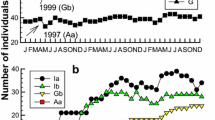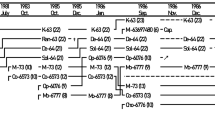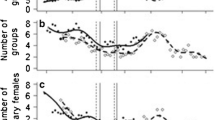Abstract
The spatiotemporal cohesion of a group is an essential element of primate society. It is thus important to clarify the factors that influence the extent of variation in spatial cohesion and individual membership in a group over time, known as fission–fusion dynamics. During the mating season of 2019, the alpha male (TY) in a wild group of Japanese macaques on Kinkazan Island repeatedly disappeared from the group, and we observed fission–fusion dynamics caused by his movement. The group seemed to have split when TY left the group or its home range, and females who followed him had the most affiliative relationships with TY or were the relatives of those females. Although TY disappeared from the group in the post-mating season, these fission–fusion dynamics only occurred during the mating season probably because females had a more substantial need for protection against aggression from the other males during the mating season. These results indicate that, although rare, fission–fusion dynamics based on affiliative relationships between males and females can occur with the separation of alpha males from the group. More studies in other populations are needed to clarify the influence of group males on the spatial cohesion of groups.



Similar content being viewed by others
Change history
22 September 2022
A Correction to this paper has been published: https://doi.org/10.1007/s10329-022-01023-y
References
Asensio N, Korstjens AH, Aureli F (2009) Fissioning minimizes ranging costs in spider monkeys: a multiple-level approach. Behav Ecol Sociobiol 63(5):649–659
Aureli F, Schaffner CM, Boesch C, Bearder SK, Call J, Chapman CA et al (2008) Fission-fusion dynamics: new research frameworks. Currt Anthropol 49(4):627–654
Chapman CA, Chapman LJ, Wrangham RW (1995) Ecological constraints on group size: an analysis of spider monkey and chimpanzee subgroups. Behav Ecol Sociobiol 36(1):59–70
Enomoto T (1981) Male aggression and the sexual behavior of Japanese monkeys. Primates 22(1):15–23
Heesen M, Macdonald S, Ostner J, Schülke O (2015) Ecological and social determinants of group cohesiveness and within-group spatial position in wild Assamese macaques. Ethology 121(3):270–283
Hikida K, Seike T (2019) Subgrouping and the emigration of the alpha male in Kinkazan A troop. Miyagiken no Nihonzaru 32:2–6 (in Japanese)
Itoh N, Nishida T (2007) Chimpanzee grouping patterns and food availability in Mahale Mountains national park, Tanzania. Primates 48(2):87–96
Izawa K (1984) Group fission of the wild Japanese monkey at Hakusan national park and its ecological meaning. Ishikawaken Hakusan Shizenhogo Center Kenkyu Houkoku 10:99–109 (in Japanese)
Izawa K (2009) The study of wild Japanese macaques. Dobutsusha, Tokyo (in Japanese)
Izawa K (2015) 33 years observing D troop. Miyagiken no Nihonzaru 29:25–39 (in Japanese)
Izawa K, Sato C (2004) A case study of troop collapse and reconstruction of Japanese macaques on Kinkazan Island. Miyagiken no Nihonzaru 17:1–43 (in Japanese)
Kappeler PM, van Schaik CP (2002) Evolution of primate social systems. Int J Primatol 23(4):707–740
Kawazoe T (2016) Association patterns and affiliative relationships outside a troop in wild male Japanese macaques, Macaca fuscata, during the non-mating season. Behaviour 153(1):69–89
Kazahari N (2015) Characteristics of B1 troop. Miyagiken no Nihonzaru 28:10–20 (in Japanese)
LaBarge LR, Allan ATL, Berman CM, Margulis SW, Hill RA (2020) Reactive and pre-emptive spatial cohesion in a social primate. Anim Behav 163:115–126
Muroyama Y (2017) Variations in within-group inter-individual distances between birth- and non-birth seasons in wild female patas monkeys. Primates 58(1):115–119
Nishida T (1966) A sociological study of solitary male monkeys. Primates 7(2):141–204
Nishikawa M, Suzuki M, Sprague DS (2014) Activity and social factors affect cohesion among individuals in female Japanese macaques: a simultaneous focal-follow study. Am J Primatol 76(7):694–703
Otani Y, Sawada A, Hanya G (2014) Short-term separation from groups by male Japanese Macaques: costs and benefits in feeding behavior and social interaction. Am J Primatol 76(4):374–384
Otani Y, Sawada A, Hanya G (2020) Spatial position-associated mating strategies employed by male Japanese macaques (Macaca fuscata yakui) in Yakushima. Primates 61(3):415–426
Saito C, Sato S, Suzuki S, Sugiura H, Agetsuma N, Takahata Y, Sasaki C, Takahashi H, Tanaka T, Yamagiwa J (1998) Aggressive intergroup encounters in two populations of Japanese macaques (Macaca fuscata). Primates 39(3):303–312
Sasaki T, Miyazaki M (2020) Troop composition and its fluctuation in Japanese macaques on Kinkazan Island. Graduation thesis, Teikyo University of Science (in Japanese)
van Schaik CP, van Noordwijk MA (1988) Scramble and contest in feeding competition among female long-tailed macaques (Macaca fascicularis). Behaviour 105(1–2):77–98
Silk JB, Altmann J, Alberts SC (2006) Social relationships among adult female baboons (Papio cynocephalus) I. Variation in the strength of social bonds. Behav Ecol Sociobiol 61(2):183–195
Sprague DS, Suzuki S, Takahashi H, Sato S (1998) Male life history in natural populations of Japanese macaques: migration, dominance rank, and troop participation of males in two habitats. Primates 39(3):351–363
Sugiura H, Shimooka Y, Tsuji Y (2011) Variation in spatial cohesiveness in a group of Japanese macaques (Macaca fuscata). Int J Primatol 32(6):1348–1366
Sugiura H, Saito C, Sato S, Agetsuma N, Takahashi H, Tanaka T, Furuichi T, Takahata Y (2000) Variation in intergroup encounters in two populations of Japanese macaques. Int J Primatol 21(3):519–535
Takahashi H (2001) Influence of fluctuation in the operational sex ratio to mating of troop and non-troop male Japanese Macaques for four years on Kinkazan Island, Japan. Primates 42(3):183–191
Takizawa H (1983) Subgrouping in Japanese macaques: the cases in Kamuri A troop inhibiting Hakusan area. Master thesis, Kanazawa University (in Japanese)
Tokita E (1981) Social life of Japanese macaques: fission of Siga-A troop. Monkey 178:6–14 (in Japanese)
Yamagiwa J (1985) Socio-sexual factors of troop fission in wild Japanese monkeys (Macaca fuscata yakui) on Yakushima Island Japan. Primates 26(2):105–120
Yamaguchi T (2020a) A strange behavior of an alpha male during the mating seasons in a troop of wild Japanese macaques on Kinkazan Island. Miyagiken no Nihonzaru 34:1–25 (in Japanese)
Yamaguchi T (2020b) A case report on the troop’s recognizable and actual spatial extent in Japanese macaques on Kinkazan Island. Miyagiken no Nihonzaru 34:62–66 (in Japanese)
Acknowledgements
We thank T. Sasaki, M. Miyazaki, M. Sekizawa, and N. Higuchi for assistance during data collection; K. Izawa for providing a research base and support during field research; the Koganeyama Shrine for providing a research base and general support; A. Suzuki for providing information from cases similar to our observations; T. Hino for supporting data analysis using GIS; and N. Nakagawa, members of the Laboratory of Human Evolution Studies, Kyoto University, and two anonymous reviewers for providing valuable comments to improve this work. This study was supported by the Japan Society for the Promotion of Science (JSPS) KAKENHI (Grant number 20J23276) and the Cooperation Research Program of the Primate Research Institute, Kyoto University for N.K. and T. Y. (2019-B-6 and 2019-B-11).
Author information
Authors and Affiliations
Corresponding author
Additional information
Publisher's Note
Springer Nature remains neutral with regard to jurisdictional claims in published maps and institutional affiliations.
Supplementary Information
Below is the link to the electronic supplementary material.
The video of the members with TY moving beyond the group’s home range on October 26. (MOV 773920 KB)
About this article
Cite this article
Yamaguchi, T., Kazahari, N. Fission–fusion dynamics in a wild group of Japanese macaques (Macaca fuscata) on Kinkazan Island caused by the repeated separation of an alpha male being followed by females. Primates 63, 575–582 (2022). https://doi.org/10.1007/s10329-022-01011-2
Received:
Accepted:
Published:
Issue Date:
DOI: https://doi.org/10.1007/s10329-022-01011-2




